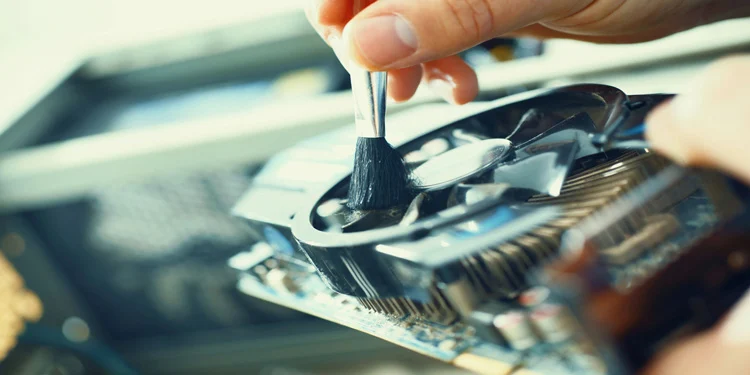Can Gaming on High Settings Damage Your Graphics Card?
It’s a question as old as PC gaming itself: can gaming on high settings damage your graphics card? As the demands of video games increase, many gamers find themselves pushing their hardware to the limits to achieve the best possible experience. But does cranking up your settings to the max lead to long-term damage to your graphics card?
Understanding Graphics Cards
Before we dive into the heart of the matter, let’s briefly touch upon what a graphics card is. A graphics card, or GPU (Graphics Processing Unit), is an essential component of a gaming computer. It’s responsible for rendering images, videos, and animations, making it a vital piece of hardware when it comes to gaming.
Game settings can range from low to ultra, with each step up increasing the demand on your graphics card. High settings, as you may expect, require more processing power and generate more heat. But does this increased demand translate into physical damage?
Can High Settings Damage Your Graphics Card?
The simple answer is no. Gaming on high settings will not physically damage your graphics card. In fact, the consensus in the gaming community is clear: as long as the card doesn’t overheat, it will be fine. The hardware is there to be used, and it doesn’t get damaged by doing its job.
While gaming on high settings won’t directly damage your GPU, overheating can. If the GPU gets too hot, it will throttle itself to cool down, or in an extreme case, it may crash. Overheating can lead to long-term damage, so it’s crucial to ensure proper cooling when gaming, especially on high settings.
Performance and High Settings
While not damaging, gaming on high settings can cause a performance loss if the game’s requirements exceed the available VRAM. When the VRAM reaches its max, the GPU will start swapping things out, similar to what happens with normal RAM. In extreme cases, it could lead to crashes.
Myths and Misconceptions
There’s a common misconception that gaming on high settings will force your GPU to work harder than it was meant to. This isn’t the case. If the GPU starts to overdo its heating capabilities, it will thermally throttle and drop its core clock automatically, ensuring it doesn’t work beyond its capabilities. So, there is no scenario in which you can damage your graphics card on accident.
While gaming on high settings won’t damage your GPU, it’s still important to be aware of the signs of a failing graphics card. These can include frequent crashes, artifacts appearing on screen, and poor performance even on low settings.
How to Optimize Your Gaming Experience
Balancing performance and visual quality is key to optimizing your gaming experience. Don’t automatically opt for the highest settings. Instead, consider the performance cost and whether the visual upgrade is worth it.
In case you want to play competitive Esports games, than maximum settings aren’t even recommended. For example, most professional CS:GO players play on a 4:3 aspect ratio and 1280×960 resolution, alongside advanced settings on low (example: NiKo config).
On the other hand, new modern games like Valorant do not even let you change the aspect ratio. It provides fairness on the Valorant competitive scene, as all player models look exactly the same. There is no setting that will help you make opponents’ heads bigger.
High Settings vs. Ultra Settings
In many cases, the visual differences between high and ultra settings are relatively small, but the performance cost can be significant. Ultra settings often provide only a minor visual upgrade over high settings at a substantial cost to performance. In many games, high settings offer a more balanced visual quality-to-performance ratio.
Game Examples
To further illustrate this, let’s take a look at a few examples:
- Watch Dogs Legion: Dropping from ultra to high settings resulted in a 47% performance increase with only minor changes to draw distance and shadows.
- Assassin’s Creed Valhalla: Switching from ultra-high to high settings saw a 14% performance increase, with the visual difference being virtually negligible.
- Cyberpunk 2077: Using the high preset instead of ultra delivered a 24% increase to performance, despite the incredibly small visual differences.
- Hitman 3: Moving from ultra to high settings gave a 5% performance improvement, with virtually no visual downgrade.
Maintenance Tips for Graphics Cards

Ensuring proper cooling and regular cleaning of your system can go a long way in maintaining the health of your graphics card. Monitor your GPU’s temperature during gaming sessions and make sure your PC’s casing allows for proper airflow.
Conclusion
In conclusion, gaming on high settings will not damage your graphics card. However, it’s crucial to ensure that your GPU doesn’t overheat and that your system is adequately cooled.
Additionally, while ultra settings may seem appealing, they often provide only minor visual improvements at a significant performance cost. Balancing visual quality and performance is key to a great gaming experience. So, game on, and rest easy knowing you’re not causing harm to your valuable hardware.

